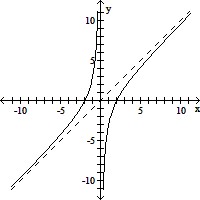Determine the upper and lower bounds on the zeros of the given function.F(x) = 2x3 - 3x2 - 4x + 4
A. upper bound: 3; lower bound: -1
B. upper bound: 3; lower bound: -3
C. upper bound: 3; lower bound: -2
D. upper bound: 2; lower bound: -3
Answer: C
You might also like to view...
Find the x- and y-intercepts. If no x-intercepts exist, state so.f(x) = 2x2 + 22x + 36
A. (-9, 0), (2, 0), (0, -36) B. (9, 0), (2, 0), (0, 36) C. (-9, 0), (-2, 0), (0, 36) D. (9, 0), (-2, 0), (0, -36)
Divide using synthetic division.
A. x4 - 2 + 
B. x4 - 3x3 + 10x2 - 30x + 90 + 
C. x4 - 2x2 + 
D. x4 - 3x3 + 9x2 - 26x + 78 + 
Use the graph to find the vertical asymptotes, if any, of the function.
A. x = 0 B. y = 0 C. none D. x = 0, y = 0
Solve the problem.The path of a projectile fired at an inclination ? to the horizontal with an initial speed vo is a parabola. The range R of the projectile, the horizontal distance that the projectile travels, is found by the formula src="https://sciemce.com/media/4/ppg__ttt0529191026__f1q91g4.jpg" alt="" style="vertical-align: -4.0px;" /> to the horizontal. Round your answer to two decimal places.
A. 290.66 ft
B. 323.50 ft
C. 161.75 ft
D. 290.76 ft
 where
where  feet per second per second or
feet per second per second or  meters per second per second. Find the range of a projectile fired with an initial velocity of 109 feet per second at an angle of
meters per second per second. Find the range of a projectile fired with an initial velocity of 109 feet per second at an angle of